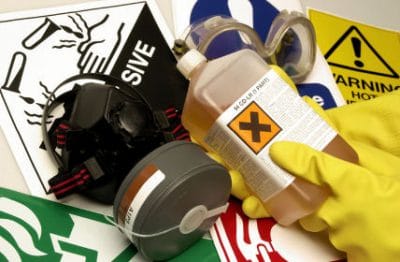
Hazardous Chemical Substances Assessments
Chemical hazards and toxic substances pose a wide range of health hazards (such as irritation, sensitisation, and carcinogenicity) and physical hazards (such as flammability, corrosion, and explosibility).
Hazardous chemical substances are found in most workplaces and include, amongst others, cleaning and disinfectant agents, paints, pesticides, and fuels. The term ‘hazardous chemical substance’ refers to any toxic, harmful, corrosive, irritant or asphyxiant substance or, a mixture of substances, including dusts, fumes, gases, mists, and vapours, that may produce adverse negative health effects in individuals who are exposed to sufficient quantities of these substances.
Where the presence of such substances is known and appropriate countermeasures introduced, such risks must be eliminated or, at least, minimised. However, to do so, it is necessary first to confirm the presence of any chemical hazards and assess the extent of the threat they might pose to workers and anyone visiting the workplace.
Hazardous chemical substances can enter the human body through inhalation, ingestion, or absorption through the skin or mucous membranes.
Some examples of the effects of hazardous chemicals include:
- Skin burns or irritation caused by contact with a corrosive liquid.
- Being overcome or losing consciousness following inhalation of toxic fumes.
- Suffering acute symptoms such as headache or nausea within hours of inhalation.
- Poisoning by absorption through the skin of a toxic substance.
- Cancer occurring years after exposure to a carcinogenic substance.
- Genetic damage to offspring occurring years after exposure to a mutagenic substance.
The health risk that may be presented to employees exposed to hazardous chemical substances in the workplace is governed by the Regulations for Hazardous Chemical Substances, OHS Act (85 of 1993).
In terms of these regulations, employers are required to:
- Carry out air monitoring by an Approved Inspection Authority annually for substances with a control limit and every two years for substances with a recommended limit.
- Zone the area as a ‘respirator zone’, where the measured concentration exceeds the recommended occupational exposure limit.
- Implement engineering control measures, administrative control measures and/or use of personal protective equipment to prevent or, where this is not reasonably practicable, adequately control the exposure risk presented to employees.
- Conduct a hazardous chemical substances health risk assessment every two years.
- Provide medical surveillance for exposed employees.
Strat Environment evaluates employee exposure to hazardous chemical substances using recognised sampling methodologies and samples are analysed by SANAS-accredited laboratories.
Strat Environment provides clients with a confidential report containing accurate and reliable results, gives reasons for non-compliance with limits, and recommends specific control measures that can be implemented to prevent or control the exposure risk to employees.
Strat Environment provides clients with several hazardous chemical substances surveys that include:
- Analysis of air, water and soil samples for pollutants and chemical composition.
- Exposure of employees to hazardous chemical substances, including dusts, fumes, gases, mists, and vapours.
- Gravimetric analysis of airborne dusts and fumes.
- Evaluation of the air purity from compressed air systems for airline breathing apparatus.
Learn more about hazardous chemical issues and how they can be resolved, by signing up for an official assessment from Strat Environment.
Sources:
https://www.osha.gov/chemical-hazards
https://www.iohsolutions.com/hazardous-chemical-substances-risk-assessment/
Enquire
